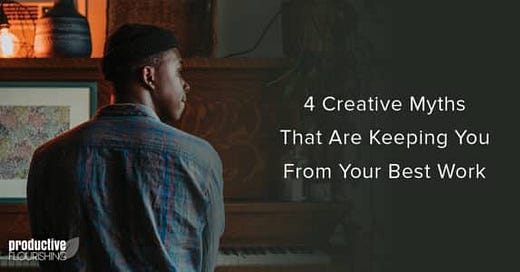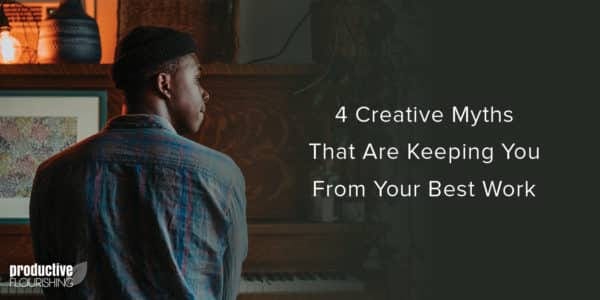It’s more than just “the system” that makes it hard for creatives; the stories we have about what it means to be a successful, productive creative person are askew. Here are some of the most common creative myths:
Creatives must be solo players. Since many creative people have been outcasts or weirdos, we’re torn between being a good team player and being the iconoclast who goes their own way. Result: we miss out on the rich opportunities for collaboration and sharing our creative gifts with others.
Creatives must be (instant) masters. Since our stories of creative heroes stress their unique, original, and high-caliber creations, we set the bar for our own creations unrealistically high: that we must create something truly original or masterful to be a legitimate creative. So we don’t give ourselves time to learn about our unique creative voice, to exercise our creative muscles, and to walk our own path to mastery. The result: we neither start nor finish very much because it doesn’t meet those unrealistic standards out of the gate.
Creatives must be martyrs. Since we’re told that creative folks have to suffer and bleed to do their best work, we stifle the natural genius and creativity we have (read: the fun part) and instead create “character-building” and redemptive work so we can be admitted to the ranks of creative people who fought, bled, and won the creative war.
Creatives must be poor. It’s the myth of the starving artist that presents the cruelest option for us: you can be creative and poor, or you can live a non-creative life and be not-poor.
Stories like these seem absurd when we hear their simple and direct versions. But a key talent of smart, creative people is that we’re able to take these simple and direct themes and turn them into nuanced, complicated, rich, and opaque myths.
These myths obscure the obvious lies behind a veil of story. These myths contort our creative souls and lead us into all sorts of false dilemmas. That so many other creative folks agree with and propagate these myths only makes it easier for us to fall prey to them.
Take the starving artist myth: how many times have you wondered whether you’d be happier creating with wild abandon despite your having to be poor(er) to do so? If you’re an artist, there’s a very good chance you’ve been some version of that one myth. My friend
wrote the book Real Artists Don’t Starve to address the many facets and nuances of this particular myth. You should check it out.It’s your belief in a myth that allows it to contort you or free you.
A myth doesn’t have to be true for it to work on you; it’s your belief in a myth that allows it to contort you or that allows it to free you.
Part of my job in Start Finishing is to drag the unconscious myths into the light of day so that we can see them for what they are and then give you the option to choose to replace them with insights and mindsets that better serve you. As long as you hold onto these and other counter-productive myths — or are held by them — you’ll continue to create the outcomes that they portend. For us to get into the doing of writing a new story, we have to believe that a new story is possible.
Add in the twelve challenges of Creative Giants and you can see why we creatives contort ourselves so. The good news here is that we can work through the stories and show them for what they really are.
Which of these lies resonate most with you?
PS: This was cut from Start Finishing. If you’d like a sample of what actually made the cut, you can get it here.





